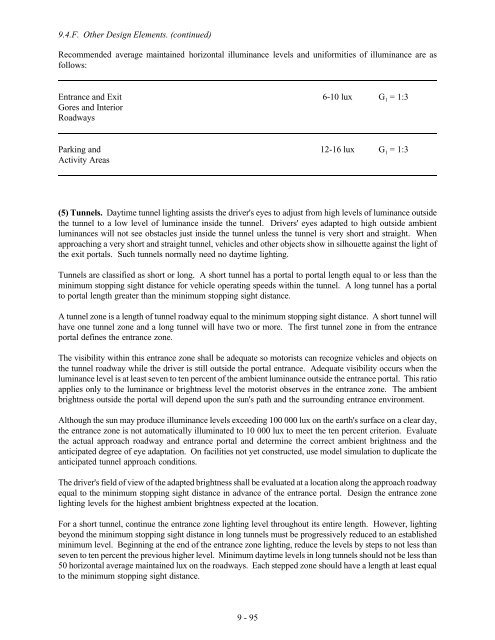FLH PDDM Chapter 9 - Eastern Federal Lands Highway Division
FLH PDDM Chapter 9 - Eastern Federal Lands Highway Division
FLH PDDM Chapter 9 - Eastern Federal Lands Highway Division
You also want an ePaper? Increase the reach of your titles
YUMPU automatically turns print PDFs into web optimized ePapers that Google loves.
9.4.F. Other Design Elements. (continued)Recommended average maintained horizontal illuminance levels and uniformities of illuminance are asfollows:Entrance and Exit 6-10 lux G = 1:3 1Gores and InteriorRoadwaysParking and 12-16 lux G = 1:3 1Activity Areas(5) Tunnels. Daytime tunnel lighting assists the driver's eyes to adjust from high levels of luminance outsidethe tunnel to a low level of luminance inside the tunnel. Drivers' eyes adapted to high outside ambientluminances will not see obstacles just inside the tunnel unless the tunnel is very short and straight. Whenapproaching a very short and straight tunnel, vehicles and other objects show in silhouette against the light ofthe exit portals. Such tunnels normally need no daytime lighting.Tunnels are classified as short or long. A short tunnel has a portal to portal length equal to or less than theminimum stopping sight distance for vehicle operating speeds within the tunnel. A long tunnel has a portalto portal length greater than the minimum stopping sight distance.A tunnel zone is a length of tunnel roadway equal to the minimum stopping sight distance. A short tunnel willhave one tunnel zone and a long tunnel will have two or more. The first tunnel zone in from the entranceportal defines the entrance zone.The visibility within this entrance zone shall be adequate so motorists can recognize vehicles and objects onthe tunnel roadway while the driver is still outside the portal entrance. Adequate visibility occurs when theluminance level is at least seven to ten percent of the ambient luminance outside the entrance portal. This ratioapplies only to the luminance or brightness level the motorist observes in the entrance zone. The ambientbrightness outside the portal will depend upon the sun's path and the surrounding entrance environment.Although the sun may produce illuminance levels exceeding 100 000 lux on the earth's surface on a clear day,the entrance zone is not automatically illuminated to 10 000 lux to meet the ten percent criterion. Evaluatethe actual approach roadway and entrance portal and determine the correct ambient brightness and theanticipated degree of eye adaptation. On facilities not yet constructed, use model simulation to duplicate theanticipated tunnel approach conditions.The driver's field of view of the adapted brightness shall be evaluated at a location along the approach roadwayequal to the minimum stopping sight distance in advance of the entrance portal. Design the entrance zonelighting levels for the highest ambient brightness expected at the location.For a short tunnel, continue the entrance zone lighting level throughout its entire length. However, lightingbeyond the minimum stopping sight distance in long tunnels must be progressively reduced to an establishedminimum level. Beginning at the end of the entrance zone lighting, reduce the levels by steps to not less thanseven to ten percent the previous higher level. Minimum daytime levels in long tunnels should not be less than50 horizontal average maintained lux on the roadways. Each stepped zone should have a length at least equalto the minimum stopping sight distance.9 - 95
















